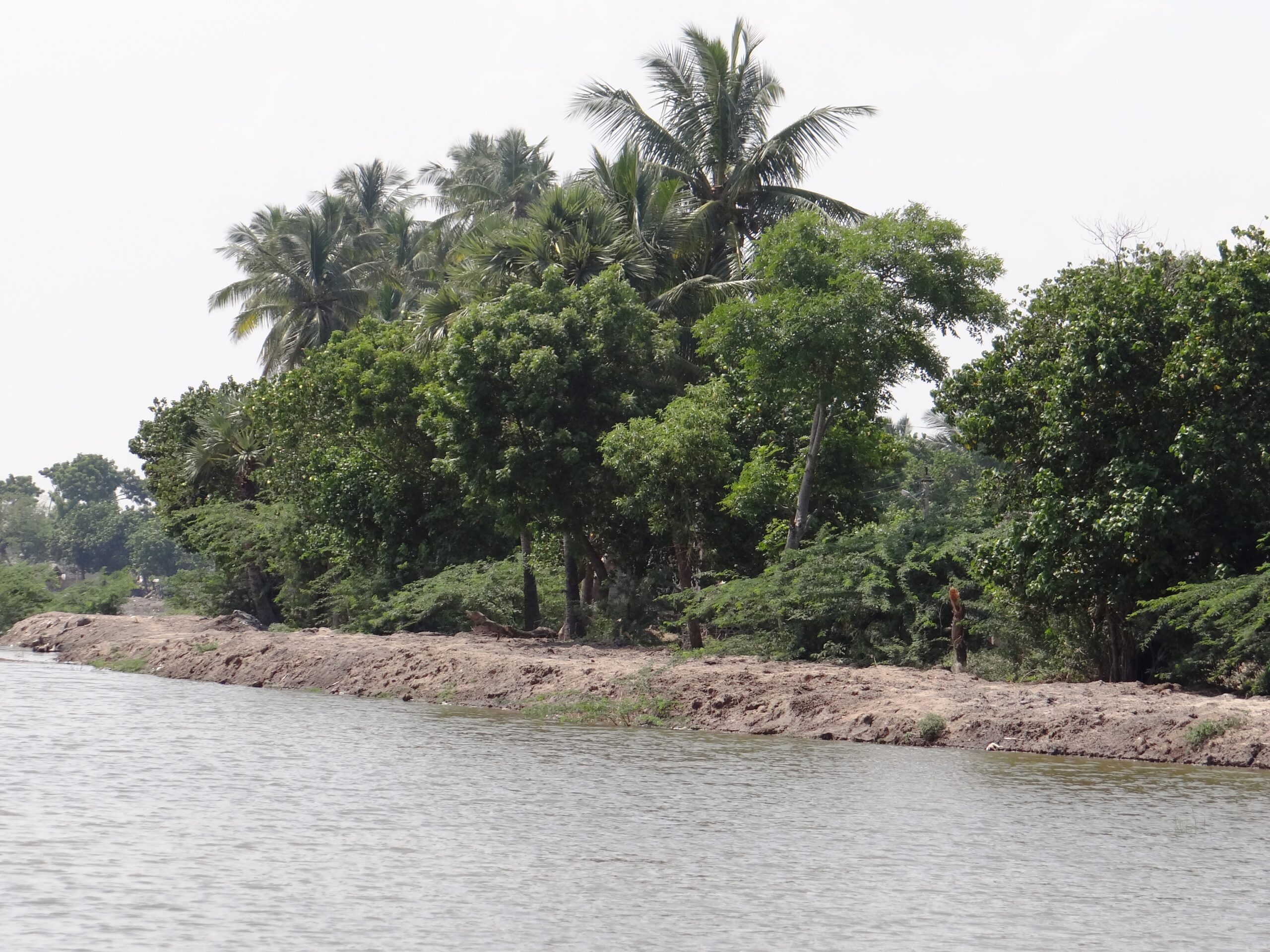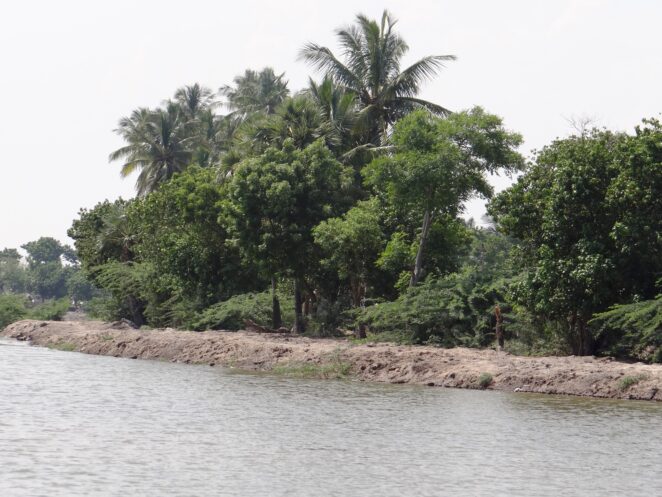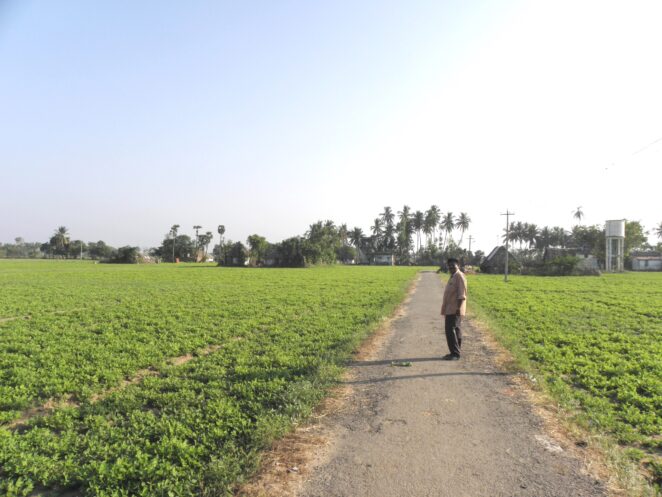Flood protection through a wing-wall river bund – Securing agriculture-based livelihoods in the coastal village of Kaduvetti, India


Kaduvetti’s wing-wall river bund
Kaduvetti, a village located 2.5 km from the shore of the Bay of Bengal in Tamil Nadu and home to 52 families, is severely affected by saltwater intrusion and flooding, which is aggravated by climate change. The nearby canal of Karungal River only used to become salty during storms when salty backwater was pushed land inwards, flooding homes and damaging fields. With rising sea levels and a growing frequency and intensity of floods the canal is now brackish throughout most parts of the year. One third of the village’s land has in fact become not cultivatable. As for most families agriculture is the main source of income, this development severely endangers their livelihoods. If harvests are lost, the village is also not able to repay loans for fertilizers, or secure another loan for the next season. The agricultural office’s interest free loans for fertilizers are contingent upon annual harvest returns.
To protect their arable land from saltwater flooding, the community – supported by the EU-financed AdaptCap project – decided to strengthen the existing river bund. The wing-wall river bund was raised and broadened and now stretches for 1km along the banks of the river to prevent an inflow of salty water throughout the year. Overall, 5,200 m3 of soil, gravel and sand were used to construct the bund, guaranteeing a high stability of the construction. The bund protects the agricultural land in use from flooding and prevents 400 irrigation ponds from becoming saline. Previously barren land has been desalinated and can be cultivated again, giving farmers’ families the chance to sustain a living again. The bund can also be used as a road and prevents homes from being destroyed during floods. This bund has significantly helped the community in Kaduvetti to safeguard their livelihoods. Strengthening the bund has resulted in:
- Flood protection: 5,200 m3 of soil protect a total of 52 families and 75 acres of land from flooding and salt intrusion.
- Increase in cultivable land and harvest: Thanks to the improved river bund an annual groundnut harvest of 37 tons can be achieved; after harvesting the groundnuts the land can be used for paddy cultivation making it possible to harvest a second crop.
Implementation cost
The overall costs of this adaptation measure – including a local vulnerability and needs assessment, capacity building measures in the community, technical support as well as material and labour costs – amounted to Rs. 304,630. Of these Rs. 284,630 were borne by AdaptCap while the community contributed Rs. 20,000.
Operation & maintenance of the system
In order to remain operative in the long run, several parts of the system require regular operation and maintenance (O&M). Regular O&M activities include:
- Verifying the constructed bund is intact
- Strengthening and maintaining the wing-wall river bund as required
- Taking care of the bund planting
The community has distributed the responsibilities for and timing of O&M activities among their members. The Village Development Committee ensures the overall functioning while the Farmers Club is responsible for the vegetation cover. The Panchayat regularly strengthens the bund.The average monthly O&M costs amount to Rs. 2,400. The local Task Force Committee collects a monthly contribution fee from all the beneficiaries in the village.
M&E of activities and benefits
A monitoring and evaluation (M&E) system was developed to regularly screen and assess the adaptation project’s sustainability and impact. Information is collected in four areas:
- Effectively achieved vulnerability reduction
- Acceptance by and technical feasibility for the community
- Cost for implementation and regular O&M
- Positive and negative side effects (i.e., environmental, social, economic)
Challenges and lessons learnt
- Ensure a strong buy-in by the community and local authorities for the measure to achieve an efficient and sustainable implementation.
- Community participation should be ensured throughout all phases of such an initiative.
- Obtain permission from relevant departments and authorities prior to executing the adaptation measure.
- Be aware of extreme weather events during monsoon season while drawing up a time schedule for implementing the measure and calculate spare time.

Groundnut fields ready to harvest on land reclaimed for cultivation
Project background and partners
The project “AdaptCap – Strengthening Adaptation Capacities and Minimizing Risks of Vulnerable Coastal Communities in India” financed by the European Commission has set out to strengthen the adaptation capacities of vulnerable coastal communities in Andhra Pradesh and Tamil Nadu (India) and minimize their climate change-related risks using an integrated approach.
The three-year initiative is implemented by the Indo-German Environment Partnership Programme of Deutsche Gesellschaft für Internationale Zusammenarbeit (GIZ-IGEP) in partnership with four Indian and international partners.
GIZ-IGEP is responsible for the overall implementation and project management.
AVVAI Village Welfare Society (AVVAI) supports the stakeholders in three cities and nine villages in Tamil Nadu as a local partner, providing training and implementation support in assessing adaptation needs and developing and carrying out adaptation measures.
Academy of Gandhian Studies (AGS) fulfills the same role in Andhra Pradesh.
adelphi contributed to developing technology solutions for the pilot projects and M&E frameworks, designing and implementing capacity building programmes and providing technical support for pilot project implementation.
ICLEI South Asia led the implementation of activities in the six urban areas targeted by AdaptCap.
(0) Comments
There is no content